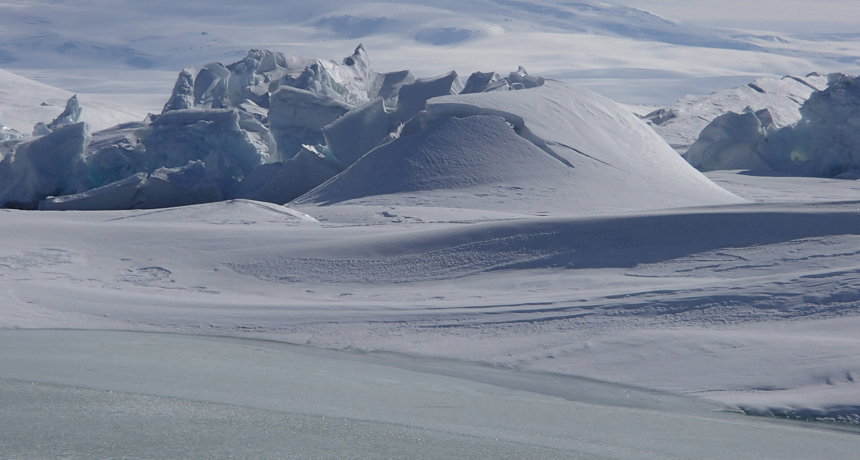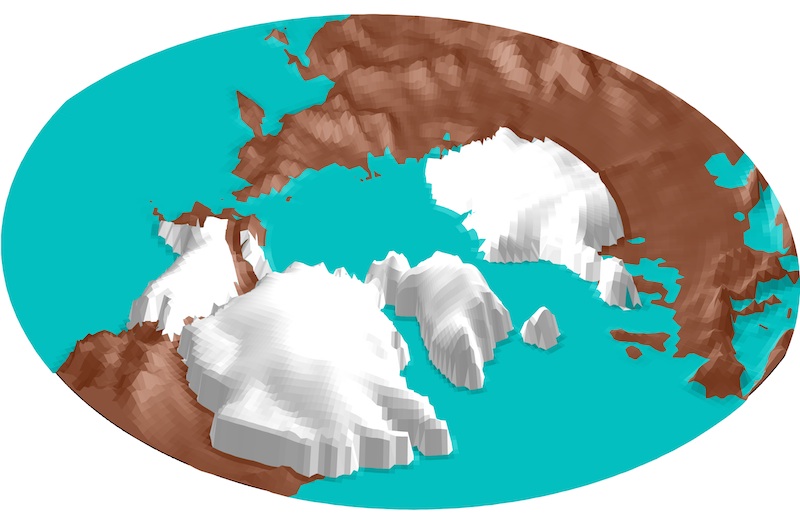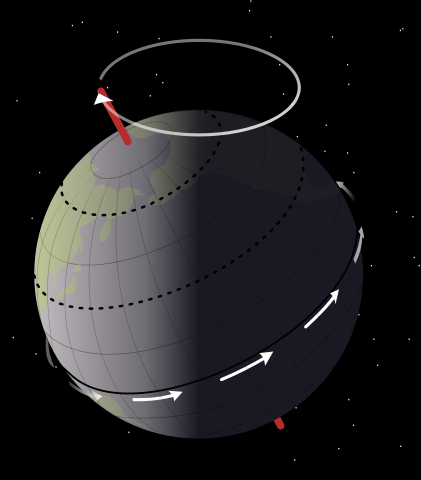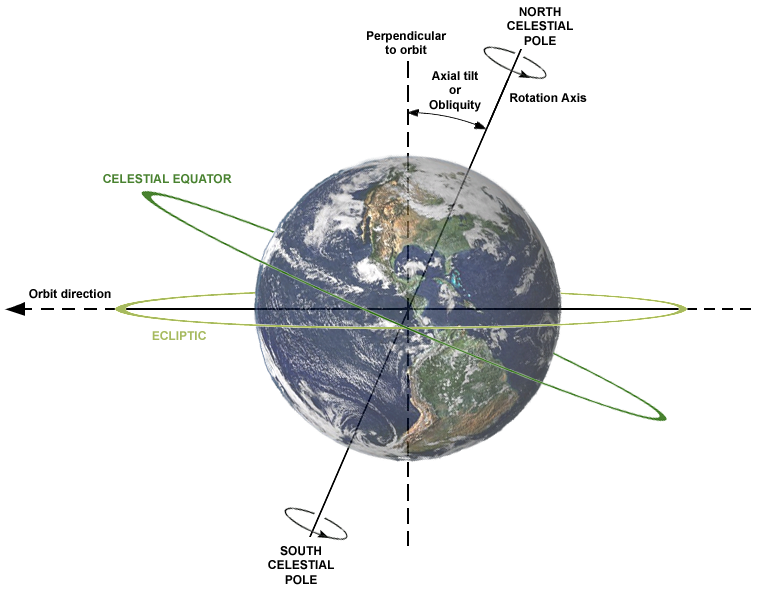Explainer: Understanding ice ages
Changes in Earth’s orbit around the sun play big roles in determining when the planet experiences a deep-freeze or thaw

At times in Earth’s history, temperatures have plummeted for decades to centuries. The buildup of snow can create what scientists now refer to as ice ages. Even in what are now temperature zones, year-round ice may cover the ground.
J. Raloff/Science News for Students
By Sid Perkins
Earth’s climate is ever-changing. At least several times in the past, a layer of ice has smothered much if not all of the planet’s surface — including its seas. The most recent time such a “Snowball Earth” existed was about 635 million years ago. At other times, global temperatures have soared so high that little if any ice remained anywhere, even near the poles. (A brief one of these so-called Hothouse Earth episodes developed about 56 million years ago.)
But those are the extremes. For most of Earth’s recent history, the planet’s surface has been subjected to a mix of hot and cold. Which has dominated — and for how long — has varied. It has tended to depend on several key factors.
One of the most important is how effectively Earth’s atmosphere traps the sun’s energy.
When the air contains large amounts of planet-warming gases, such as methane and carbon dioxide, global temperatures can soar. (In the distant past, levels of both gases often rose due to widespread volcanic activity. Today, carbon dioxide levels are rising because people burn fossil fuels in vehicles and power plants.)

Generally, when levels of these gases fall, so do temperatures across the globe. (There are exceptions, however. The gradual erosion of mountains can trigger chemical reactions that can remove carbon dioxide from the air. That, too, can trigger a long-term cooling.)
Starting about 2.6 million years ago, Earth experienced a number of ice ages. Those cool spells — possibly 40 or more of them — didn’t cause the entire planet to freeze, as likely happened in Snowball Earth eras. But these extra-cool periods did trigger the formation of large, thick sheets of ice in some parts of the Arctic. The largest and thickest ice sheets were centered over eastern Canada. But during the peaks of some ice ages, the ice spilled south into what is now the United States. The most recent ice age ended about 12,000 years ago.
In North America, the last four ice-age cycles lasted about 100,000 years each. That includes a roughly 10,000-year warm spell between each ice age. So, the ice ages themselves lasted, on average, about 90,000 years. During each cold spell, the ice sheet gradually grew to large size. Then it retreated suddenly and disappeared.
For a long while, scientists wondered what caused this pattern. Then a Serbian scientist named Milutin Milanković (Mih-LAN-koh-VITCH) noted that the pattern appeared tied to long-term changes in Earth’s orbit around the sun. Scientists now recognize orbital features can play a major role in long-term shifts in climate.
Changing orbits and tilts
Earth’s orbit is largely stable (thankfully!). Yet there are small changes in certain aspects of Earth and its orbit that vary in predictable ways, Milanković noted. Importantly, all of these changes affect the strength of sunlight reaching Earth’s surface.
One aspect of the orbit is its eccentricity (Ek-sin-TRISS-ih-tee), or roundness. At times, the planet’s orbit is almost perfectly circular. At others, its path around the sun becomes more like a slightly squished oval. When the orbit is its most squished, Earth’s distance from the sun at its farthest is about 3 percent further than when it is at its closest point for the year.
That might not seem like a lot, but it means that the sunlight falling on the planet is about 6 percent stronger in some seasons than in others. More sunlight will contribute to greater warmth. It takes about 100,000 years for Earth’s orbit to vary from near-circular to squished and then back again to near-circular. This change stems, in large part, from the gravitational tuggings exerted on Earth by Jupiter and Saturn, the largest planets in our solar system.

Another slowly varying aspect of Earth’s orbit is the tilt of the planet’s axis. Right now, the line that runs through Earth’s north and south poles is tilted about 23.5° from the direction that our planet travels around the sun. This tilt, known as obliquity [Oh-BLIK-wih-tee], gives Earth its seasons.
For instance, when the North Pole is generally pointed toward the sun, the Northern Hemisphere receives sunlight more directly and experiences warmer months. It takes about 41,000 years for Earth’s axis to shift from a tilt of 22.1° to 24.5° and then back again. When the axial tilt is at the low end of its range, Earth’s seasons are more even. Summers aren’t too hot; winters don’t get as cold. But when the tilt is higher than average, the temperature shifts between summer and winter become more extreme.
Finally, Earth slowly wobbles as it rotates. Right now, our planet’s North Pole constantly points toward a spot near a star named Polaris. (That’s why this star is also commonly known as the North Star. Hikers and ship captains in the Northern Hemisphere often use Polaris to help them navigate, because it always sits in the same spot in the night sky.) But because Earth isn’t a perfect sphere and its axis is tilted, the gravitational pulls of the sun and moon cause Earth’s axis to wobble. (The motion, called precession, is similar to a spinning top wobbling on a tabletop as it slows down.) It takes about 26,000 years for Earth to complete one wobble.
These three cycles — of eccentricity, obliquity and precession — have different lengths. In some instances they line up. Most of the time, they do not. (Like waves on a pond or the sea, sometimes the planet-warming effects of these cycles stack up and reinforce each other. At other times, they may tend to cancel each other out.) For the Northern Hemisphere’s ice sheets, the biggest factor affecting their growth is the amount of summer sunlight in the Arctic, scientists say. When the summer sun is relatively weak, some of the snow that fell in the previous winter may not melt. Then slowly, year by year, snow starts to build up. In time, an ice sheet will amass that grows thicker and spreads farther.
After an ice sheet develops . . .
Once ice sheets start to grow, another factor kicks in. It too will help snow accumulate. We’re referring to the amount of sunlight that the ground reflects back into space. Scientists call this Earth’s albedo. White surfaces reflect more sunlight — a source of heat — than do dark surfaces. So an ice sheet will tend to stay cooler than will bare rocks and soil. Snow and ice also last longer when temperatures are cooler. That means that once ice sheets start to grow, they help themselves grow even more.
This ability of one factor to reinforce another is called a feedback. And here, the buildup of snow whitens the ground — increasing its albedo. This, in turn, reflects more of the sunlight that might otherwise have fostered melting.
Together, eccentricity, obliquity and precession join to make one cycle that lasts about 100,000 years. That roughly matches the length of recent ice-age cycles in North America, scientists have noted. But that match did not explain why ice ages start gradually but end suddenly.
In 2013, some researchers offered a possible explanation. They used computers to predict the warming from sunlight that falls on Arctic regions. They also included a second factor, the effect of a gradually growing ice sheet on Earth’s crust.

Explaining abrupt ends
When an ice sheet first starts to grow, it doesn’t weigh much. But an ice sheet 3 kilometers (almost 2 miles) thick will be crushingly heavy. In fact, it causes Earth’s crust to sag down about 1 kilometer (around 0.6 mile). Even though the sagging will be largest beneath the center of the ice sheet, the edges, too, will dip to lower altitudes. And that has a very important effect: Because temperatures at lower altitudes are warmer than those higher up, the heavier an ice sheet becomes, the more likely it is to melt around the edges.
Once all three of the orbital cycles team up to provide maximum warmth, an ice sheet will melt away. Indeed, it will disappear before Earth’s crust can spring back upward to cool and save it.
Later, after Earth’s crust has risen back close to its normal level and the three orbital cycles gradually move out of sync, Northern Hemisphere summers cool off a bit and ice sheets again can begin to grow. The researchers reported their findings in the August 8, 2013, Nature.
That’s one possible explanation for the gradual growth and sudden demise of ice sheets, scientists say. Here’s another possibility: A thicker ice sheet more effectively traps heat coming up to the surface from Earth’s interior. That, in turn, helps melt ice at the bottom of an ice sheet. That melting then helps the ice sheet flow like a glacier, become thin at the edges and melt back even more.
Other factors surely play roles in the growth and demise of ice sheets. For instance, ice sheets typically trigger changes in weather patterns across broad regions, scientists have shown. Some areas don’t get as much rainfall as before. This makes them dry up and produce lots of dust. If that dust gets swept up into the air and later falls on the ice sheet, it will darken the ice. That ice will now absorb more sunlight. This will make it melt more quickly than if it were clean. (There’s the albedo effect again!)
Finally, how much carbon dioxide exists in Earth’s atmosphere can affect temperatures near the surface. Right now, the average global concentration of that planet-warming gas is almost 400 parts per million (it was 396 ppm in 2013). It had ranged only between 180 and 280 ppm for the last 400,000 years. But then people began adding large amounts of carbon dioxide to the atmosphere, starting in the 1700s, with the beginning of the Industrial Revolution.
According to Earth’s orbital cycles, our planet might be overdue for the next ice age. But with so much carbon dioxide now in the atmosphere, that ice age might not arrive for a very long time — if it comes at all.







